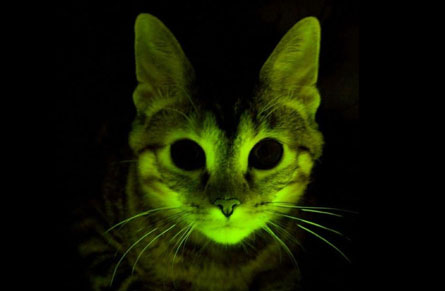- More than 2 years ago
A new breed of glowing green kitties may represent a first step in creating cats that are resistant to feline AIDS, and possibly give clues about fighting HIV infections in people.

The kittens are engineered with a gene that makes an antiviral protein that scientists hope will combat feline immunodeficiency virus, or FIV. Another inserted gene makes the cats glow under fluorescent light so scientists can readily confirm the success of the procedure. Researchers at the Mayo Clinic College of Medicine in Rochester, Minn., and Yamaguchi University in Japan report the accomplishment online September 11 in Nature Methods.
HIV has killed millions of people worldwide and infects millions more; FIV is causing a similar worldwide epidemic within the feline population, says study leader Eric Poeschla, a molecular virologist at the Mayo Clinic.
Part of the reason cats fall prey to the virus is because they lack a key immune protein called TRIM5alpha, which helps fight viruses even before the rest of the immune system knows an infection is under way, Poeschla says. He and his colleagues decided to do “an evolutionary experiment” to see if inserting this antiviral protein would protect cats from FIV.
The researchers collected eggs from ovaries left over after spaying procedures and injected them with viruses containing genes for a rhesus monkey version of the antiviral protein and the green fluorescent protein. The viruses inserted the genes into the eggs’ DNA. After fertilizing the eggs, the researchers transplanted the resulting embryos into the wombs of feline surrogate mothers. In the end, three transgenic kittens — meaning kittens carrying foreign genes — were born; two males and one female. Because the cats carry the foreign genes in every cell, including eggs and sperm, the animals have been able to pass the genes on to kittens of their own.
Poeschla and his colleagues don’t know yet whether the monkey gene will protect the cats from getting FIV. The team needs to do more genetic experiments and breed the cats to get enough animals to test immunity to the virus, Poeschla says. If the experiments are successful, the cats could be the first of a new breed immune to the virus. The researchers also hope studying the cats will show how the TRIM proteins work, something that could be important for protecting humans from HIV.
These are not the first cats to glow: Scientists have previously used a cloning procedure called somatic cell nuclear transfer to create transgenic cats that carry genes for fluorescent proteins. But these cats are the first to carry two foreign genes, says Martha Gomez, a reproductive biologist at the Audubon Center for Research of Endangered Species in New Orleans, and one of the scientists who created cloned fluorescent cats.
It remains to be seen whether the newly created cats will be able to pass along any protection their foreign genes might confer for more than one generation. Unpublished data from Gomez and her colleagues suggests that foreign genes are shut off before reaching a second generation of kittens. That could limit the usefulness of the technique for making multiple generations of transgenic cats, Gomez says.






